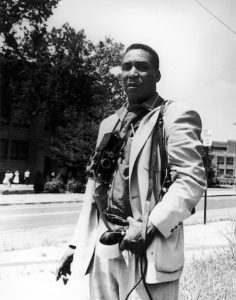
Ernest Withers
*Ernest Withers was born on this date in 1922. He was a Black freelance photographer and FBI informant.
Ernest C. Withers was born in Memphis. After high school, he worked as a photographer in the Army in World War II and started a studio when he returned. He also worked for about three years as one of the first nine Black police officers in Memphis. He was famous for his black-and-white images of the segregated South in the 1950s and 60s, including the Negro League Baseball and the Memphis blues music scene.
His images captured America for nearly 60 years, preserving the good and the bad, particularly racism. Withers' coverage of the Emmett Till murder trial brought national attention to the racial violence taking place in, among other places, in the 1950s. Withers appeared in a TV documentary about the murdered 14-year-old entitled The American Experience: The Murder of Emmett Till. As an FBI informant, he traveled with Dr. Martin Luther King Jr. during his public life. He died from complications of a stroke in his hometown of Memphis, Tennessee, on October 15, 2007.
The Ernest Withers Museum and Collection opened on Beale Street in Memphis, Tennessee, in May 2011. The Museum features images of Ernest Withers spanning the eras of his work, while the complete archive is held in an off-site location. The Withers Museum and Collection is approximately 7,000 square feet. In 2013, the FBI released documents relating to Ernest Withers in response to a Freedom of Information Act (FOIA) request by a Memphis newspaper, The Commercial Appeal.
The documents begin in 1946 with the FBI investigating Withers as a possible communist, as he was a member of the United Negro Allied Veterans of America (UNAVA) after serving in World War II. The group was thought to have communist ties. A 1968 document contains the first reference to an informant, ME 338-R (Ghetto), widely believed to reference Withers and inferred by the FBI's responses to FOIA court actions. ME 338-R(Ghetto) provided various general information, including pictures and brief descriptions of meetings and events.
There is limited specific information, commonly relating to a militant group named the Invaders. ME 338-R(Ghetto) recorded the violence and connections of the Invaders, including a leaflet on the manufacturing of firebombs and links to prostitution. ME 338-R(Ghetto) was an informant for two years, from 1968 through the final report in 1970, with 19 reports that include some reference to the informant; the informant in the released documents provided a total of 10 pictures. Withers died years before the FOIA request was made; thus, no direct response was possible.
However, at the 2000 Withers exhibition at the Chrysler Museum of Art in Norfolk, Virginia, Withers said he had FBI agents regularly looking over his shoulder and questioning him, "I never tried to learn any high-powered secrets," Withers said. "It would have just been trouble..… [The FBI] was pampering me to catch whatever leaks I dropped, so I stayed out of meetings where decisions were being made." Andrew Young commented after the release of the FBI file, "The movement was transparent and didn't have anything to hide anyway."